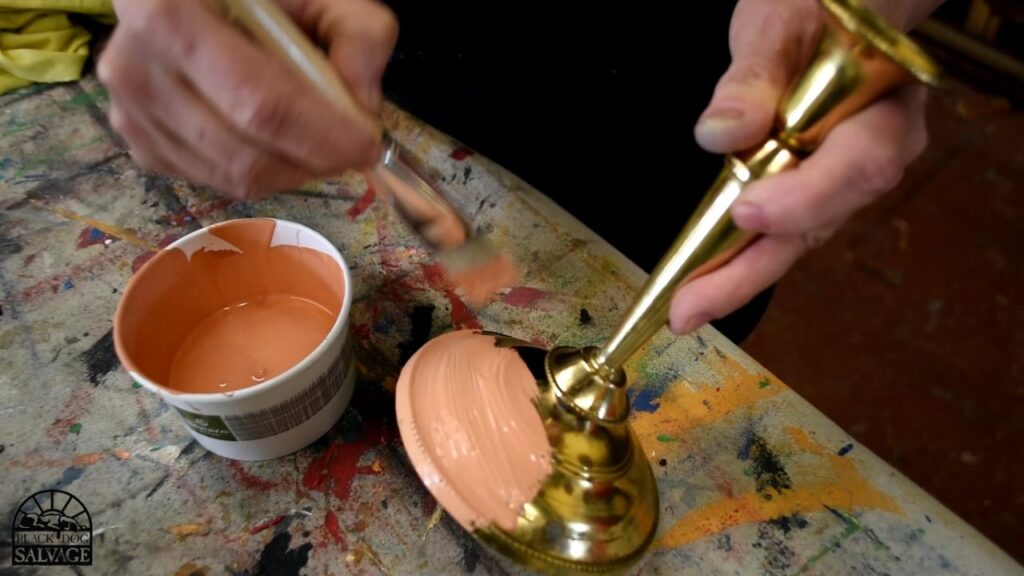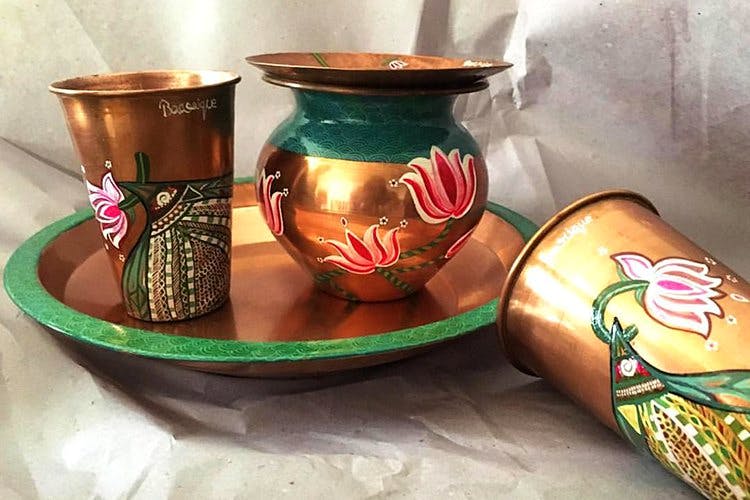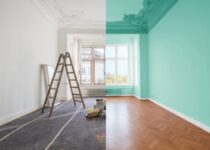Can you paint brass metal surfaces
Brass is a go-to metal for producers and buyers alike when it comes to home decor, home furnishing, and other handicrafts and utensils of daily use. It is a special alloy created in such a way as to possess the properties of durability and non-corrosivity even after long-term daily use.
However, who will not agree that the beauty of brass can be increased by adding to it some decorative additions?
One such addition, no doubt, is the use of paint to create beautiful artwork on the brass body. If you are a fan of brass there are chances you have seen this being done. And there is also a chance that you want to do it yourself.
In this article, we are going to look at a number of ways in which you can paint the brass and give it a professional finishing.
Just like most metallic, glass, and ceramic surfaces, the success of painting on brass depends on how the brass surface is prepared before the process is commenced. It is important to not skip on proper cleaning processes and the use of proper paint medium and tools.

How to make sure your brass painting process is a success?
Acid before brass can be painted relatively easily into a wide variety of shades and hues as long as the creator possesses some basic knowledge on how to make the paint stick on brass. It is usually hard to make the paint stick on solid surfaces, especially so on metals.
Because of the shine and luster along with its ultra smooth top surface which allows no texture for the paint to hold on to. Along with that most finished brass products come with a top quote of vanishing and polishing which does not let the paint reach the actual brass surface.
Therefore, investing in proper cleaning tools, a primer intended for this purpose, and the best quality varnish is the first step.
Benefits of painting brass
Painting brass can have many benefits on the overall beauty and value of any product or item of daily use. It increases the market value of items you are selling. Brass is a metal alloy and most metals benefit majorly from a correct paint job. Brass painting can really help you overcome some important shortcomings which your work on brass might be facing.
Painting brass can elevate its aesthetic quality and value
Adding the correct colors and designs to any object made out of brass can elevate its aesthetic quality. It makes your product stand out from all the others in the market. This increases product value and popularity.
Painting your brass product with bright colors can also make it more attractive to users, therefore, increasing sales. In the digital market, sales are majorly dependent on visual first impressions. Therefore you can really benefit from investing some time in painting and designing your brass product.

Brass painting can expand the usage of brass to unconventional niches
These days brass metal is being used in niches where it had never been used before. Such niches include jewelry making, desk decor and furnishing, stationery holders and decors, decorative add-ons in bags and portable accessories, etc.
These would not have been possible without the correct use of brass painting techniques. And these techniques make brass products go with any and every color scheme and aesthetic. Painting brass really expands its usage to any and every field, with only your imagination as the limit.
Brass can be painted to give it a special rugged look
These days vintage looks are trending and metal frames and holders are being used widely to manufacture vintage products. Experienced creators have realized early that brass is the most suitable of all metals for daily usage by customers around the world.
It is harder to damage brass than traditional metal materials, it is corrosion free and easier to paint and decorate. Therefore, brass painting techniques are being used to complete professional or DIY vintage furniture projects.
Painting brass is a great way to upcycle and renovate old brass materials
Old metal objects can often be easily upcycled and recrafted into beautiful decorations that look almost as good as new. A good quality paint job can also furnish as an alternative to polishing. You can even use these tricks to upgrade your old house decor or thrift brass goods.
On brass furnishings like door handles and chair legs, you can use a good paint job as a cost-effective alternative. And the best part I,s you can undertake these painting projects yourself at home. If you enjoy remodeling old goods and decors, painting brass is a skill that you should definitely invest your time in learning.
A correct paint job can protect the brass surface for a long time increasing its durability
One of the main benefits which draw creators to the brass painting process is the protection a well-incorporated paint job provides to the brass surface. You can enhance the durability of your brass products exponentially by painting them correctly. Painting protects your brass object from oxidation, denting and scratching, pigmentation, dirt, dust, etc. A painted brass product is easier to clean for your customers. It also remains like new for a much longer time.
Painted brass objects have an increasing market value due to their stable trendiness
Brass decorations are trending all over the digital marketplace at present. This means diversifying your brass product models and introducing new designs are a great way to increase sales. The whole process becomes super easy once the creator learns the correct basics about painting and decorating their brass metal creations. This is why learning how to paint brass is more important today than it was before.

How to clean and prepare your brass product for the painting process?
Cleaning any metal surface before the painting process is started is essential. Not only must the metal surface be cleaned, but also the right products must be used with extreme caution. Dry and wet debris needs to be removed from the corners and crevices of your brass object. Only after a thorough cleaning can you start with the priming process.
Otherwise, this build-up often interferes with the paint finish by creating bumps and uneven surface texture in the end result. If your brass object is relatively new, cleaning it using a metal-friendly detergent and water will be enough. A good quantity of dish soap might also work.
However, for more complex surfaces rubbing alcohol or other cleaning agents like grease-fighting cleansers can be used.
There might be additional problems to your brass surface like corrosion or oxidation. Using commercial tarnish remover and oxidation repairing chemicals is essential before starting out on the priming step.
An extra step to increase the value of your brass product is the use of sandpaper to sand down the corrosion. It removes the upper layer of the corroded surface while also improving the brass surface texture. This way the paint holds on better on the brass surface.
If you have a polished and varnished brass surface, using steel wool or sandpaper to sand down your brass is a good idea. You can further use fine grit sandpaper to finish off perfecting your metal surface.
Priming your brass
Like most metal surfaces priming your brass object before you start the painting process is absolutely necessary. In practical situations, the kind and quality of primer you use do depend on the quality of your paint, your brass object, and how they go with each other.
What this means is that by not priming your surface you might be compromising on the finishing of your paint as it might not be as smooth or fine as you want it. Why should you prime your brass surface and which areas should you focus on?
- If your brass has imperfections like cracks and holes, a paint primer can seal these imperfections. It helps to give us smoother finishing. Sometimes these imperfections are not visible to the naked eye.
- If your piece of brass is especially rough and you want it to be kept so as an artistic choice, the best thing to do is to apply two coats of paint primer on the top surface very carefully. Remember to cover all cracks and corners. This keeps the overall rugged look intact without letting it affect the painting process.
- When your brass is old or you are working on patched or repaired brass pieces, it is best to cover the entire area with a good paint primer. Why? So that the cracks in between, as well as the imperfections and compounds like filler or glue, can be prevented from causing a mishap during painting.
You should definitely let the primer try for 24 hours before the next step starts. What should not be forgotten is that primers need curing too.
What kind of paint should be chosen for my brass product?
A well-prepared and primed brass surface is likely to respond well to most synthetic paint types. There are paint variations available in the market which are dedicated to metal surfaces and even brass surfaces in particular.
But if you are a regular creator who already has a stash of paints left back at home, the good news is you can use these paint tubes to create a masterpiece as well. In fact, any permanent paint can be used to paint a brass surface adequately.
Which paints are good?
Paint mediums to which brass surfaces respond very well to are acrylic paint, latex paint, or enamel paint( latex and enamel difference shared here). If you are preparing your brass product for indoor use latex paint or water-based acrylic paint works very well. These are the less toxic variations and are also more budget-friendly.

Which is the best paint for the outdoors?
If your brass products or painting process involves materials and objects to be used in the outdoor setting, it might be a good idea to explore the oil-based or solvent-based paint options. checkout can you use inside paint outside or not to know more interior and exterior paint types.
What are protectant paints?
These will protect your brass surface and make it resistant to heat and moisture exposure. Solvent-based paint products can be toxic to the human body. It will require you to invest in protective gear and proper painting techniques to keep yourself and your loved ones away from harm.
Using a good varnish
Sealing the paint is as crucial as other steps in the process. Invest in a sealant built especially for brass surfaces and quote it on top of your paint job. This means you are not only protecting your paint with one additional procedure but also increasing the product value of your creation.
Sealing is the primary way of upgrading the overall look of metal items since they add extra gloss and shine to the painted surface.
Remember to let your brass dry thoroughly between each additional coat of paint. The same is the condition for a good priming or sealing process. Let the paint cure for 24 to 48 hours. This really depends on which paint medium you are choosing. After the curing process is complete, apply the sealant. Some paint variations also require a longer curing time like 3 to 4 days.
Conclusion
Painting metal surfaces is usually a fun process once you get a hang of it. Painting can enable you to add variations to your product models and also bring a change in the atmosphere of your overall brand. So, make sure to give it a try.
FAQ
Is it okay to paint brass utensils?
Many paint types are highly toxic and should never be used in products that are created for eating. Brass utensils should only be painted when you are certain that your paint medium is food friendly.

Should I procure a high-quality primer?
Investing in a high-quality primer is even more important than investing in high-quality paint sets. A good quality primer will help your paint last longer and also improve its finish quality.
What protective gear should I wear while painting brass objects?
General protective gear won during painting processes like aprons, gloves, masks and head caps must be wanted during the painting of brass surfaces as well.

Being associated with art and craft field since decades as a hobbyist and life long learner has given me an opportunity to learn many new things related to art, craft, paints and pottery which i am trying to share with your guys on this website. I have expertise of being professional painter and potter for the last 20+ years
I have learned mind blowing cool tips and insights which makes me a person with ability to improvise and come up with creative ideas and solutions to make stunning and impeccable art pieces of all types which are adored by people across the globe on this website and other platform.


